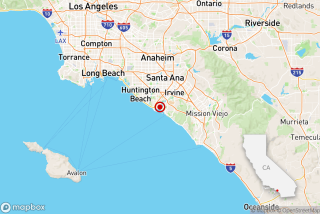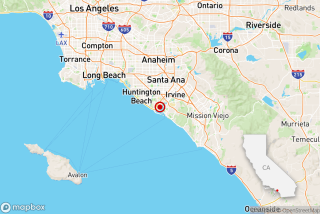SOUND OFF!
- Share via
Caltrans’ division of aeronautics has established guidelines to control the amount of noise generated over residential areas by aircraft using the state’s airports. Under those guidelines, any area exposed to an average Community Noise Equivalent Level (CNEL) of more than 65 in a year is considered to be noise-impacted.
To comply with those regulations, John Wayne airport has set up nine stations at locations in Newport Beach, Santa Ana and Tustin to monitor noise levels. Some stations are on private property and others on public land, at the following locations:
MONITOR STATIONS
M-1: 2139 Anniversary Lane, Newport Beach
M-2: 1907 Tradewinds Lane, Newport Beach
M-3: 2601 Vista del Oro, Newport Beach
M-4: 1352 Reynold Ave., Santa Ana
M-5: 17952 Beneta Way, Tustin
M-6: No longer in use
M-7: 20181 SW. Birch St., Santa Ana
M-8: 1131 Back Bay Drive, Newport Beach
M-9: 1300 S. Grand Ave., Santa Ana
M-10: Golf Course, 3100 Irvine Ave., Newport Beach.*
The stations monitor the noise levels on a daily basis. The average daily levels, which are also averaged for each month, are “the result of a computer analysis based on county-provided data including flight tracks, actual traffic counts, average SENELs (Single Event Noise Exposure Levels) by aircraft model and recorded CNEL values for each monitor station,” according to the quarterly report from the airport’s Noise Abatement Office.
COMMUNITY NOISE EQUIVALENT LEVELS Monthly averages: April-June, 1988
Month M-1 M-2 M-3 M-4 M-5 M-7 M-8 M-9 M-10 April 64.2 56.6 55.7 63.6 53.0 65.1 56.4 45.6 66.7 May 63.7 56.3 55.2 63.8 52.8 64.7 56.2 48.2 66.2 June 64.3 56.9 55.3 63.8 53.1 65.2 56.7 46.6 66.5
As of the end of June, a total of 42 homes in Newport Beach and Santa Ana Heights are in a noise-impacted area. The state has several remedies for property owners in the area: the homes can be insulated, they can be purchased by the county, or the sites can be re-zoned for “other non-noise sensitive uses,” according to Lynn Dosheery, a county planner who serves as the Santa Ana Heights project manager. For instance, the zoning in the area along Acacia and Birch streets in Santa Ana Heights has been changed from a general agricultural use to a business park, she said.
TELEPHONE COMPLAINT CALLS April-June, 1988
The airport’s Noise Abatement Office logs noise complaints from local citizens. During the second quarter of 1988, the office received a total of 650 noise complaints from local citizens. This represents a 4% decrease from the number of complaints received the previous quarter but a 129% increase over the number of complaints logged in the second quarter of 1987. According to airport spokeswoman Kathie Rutherford, residents in the Balboa area made “a concerted effort” to call in their noise complaints.
Each complaint is investigated and the operators of flights found to have exceeded the maximum noise levels are notified. According to an airport spokesman, the valid complaints normally correspond to noise readings taken by the monitors.
Area: First Quarter, Second Quarter
Tustin/Orange: 21, 22
Santa Ana: 10, 11
Santa Ana Heights: 71, 67
Costa Mesa: 15, 8
Westcliff, Newport Beach: 32, 58
Eastbluff, Newport Beach: 38, 104
Balboa/Corona del Mar: 462, 354
Other areas: 28, 26
More to Read
Sign up for Essential California
The most important California stories and recommendations in your inbox every morning.
You may occasionally receive promotional content from the Los Angeles Times.













